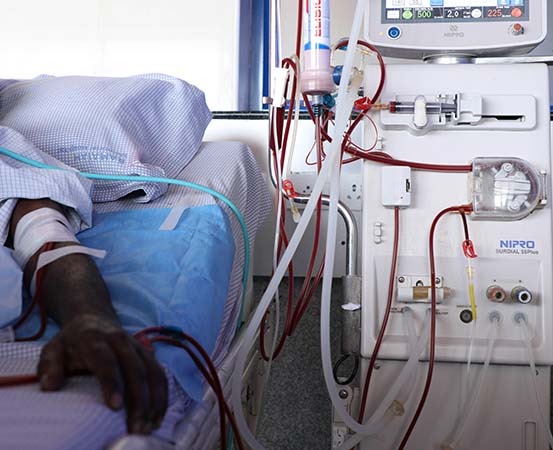
For the last five years, Manjima Ganguly, 50, a product executive and training manager from Kolkata, has been on dialysis. However, her chronic kidney disease (CKD) does not come in the way of her work. She has zealously continued managing her work while taking care of herself with peritoneal dialysis, a type of dialysis one can do at home with proper medical guidance.
Ganguly had started experiencing symptoms like difficulty in urinating and swelling in the face and feet in 2018. Soon after, she was diagnosed with failing kidneys and was asked to take up dialysis as a life-saving measure. Being at the peak of her career, she sought a solution that would minimally affect her professional life. Then, her doctor suggested peritoneal dialysis, which would allow her to manage her condition at home. “Peritoneal dialysis has been a blessing for me,” shares Ganguly, who is well-versed in using a catheter and fluid collection bags.
What happens in peritoneal dialysis
A person with chronic kidney disease can survive either by being on dialysis to purify blood or going for a kidney transplant through organ donation.
There are two types of dialysis:
- Hemodialysis: Here, a dialysis machine and a special filter are used to clean the blood. Dialysis is performed twice or thrice a week.
- Peritoneal dialysis: Waste is filtered from blood through the lining of the abdomen (peritoneum) in the body. This is done thrice a day.
Depending on the severity of the condition, the treating nephrologist decides the type of dialysis.
For peritoneal dialysis, a small tube called a catheter is surgically placed in the person’s abdomen. The peritoneal cavity (natural filter in the abdomen) is then filled with the dialysis solution. It is a clear fluid, which draws waste products from the peritoneal cavity. The catheter filters the waste products out of the system.
Dr Garima Aggarwal, consultant nephrologist and transplant specialist, Manipal Hospital, Bangalore, shares, “The peritoneum or the inside layer of the abdomen is filled with blood vessels, which have semipermeable membranes filtering the high-concentration fluid. The blood vessels filter impure substances from our blood. Once the highly concentrated substances are filtered out, the dialysis solution is drained from the abdomen through a catheter.
Two types of peritoneal dialysis
-
Continuous ambulatory peritoneal dialysis (CAPD)
This is a manual technique in which the dialysate is delivered into the peritoneal cavity through a catheter. Once the fluid fills the abdomen, the catheter is closed with a cap. The fluid remains in the abdomen for about 5-6 hours (dwell time) while the person can continue their regular activities. Later, the fluid with the toxins from the abdomen is filtered into a pouch (fluid exchange process), which takes about 30-40 mins. “The dwell time usually varies according to the prescription. Moreover, the fluid exchange must be done about three to four times a day,” says Dr Tanmay Pandya, HOD & director, nephrology and renal transplantation, Sarvodaya Hospital, Faridabad.
-
Automated peritoneal dialysis (APD)
In this process, the delivery and the drainage of the dialysate are done by a dialysis machine. The procedure is usually performed overnight, while the patient is asleep. “In APD, the dwell and the exchange are programmed by the machine. About 10 liters of fluid exchange takes place overnight,” explains Dr Pandya. “It is programmed for four to five exchanges, as suited to the person,” he adds. “About two liters of fluid are filled and drained out during each exchange,” he says.
Ganguly is using the CAPD method. This process became convenient for Ganguly as she was able to integrate it into her daily routine and work after dialysis. “It takes about 45 minutes to carry out each exchange process and I have to do it thrice a day,” she shares.
Beware of infections
Dr Pandya warns that those on dialysis, especially people using the peritoneal method are vulnerable to infections and must follow the highest levels of hygiene. Peritonitis is one of the common infections seen in those undergoing peritoneal dialysis. It occurs when the fluid remains in the peritoneum for a prolonged time or due to a lack of hygiene during dialysis. Dr Pandya explains, “This infection in the peritoneum causes inflammation in the abdominal lining. When a person on peritoneal dialysis notices such pain, it is best to seek medical advice,” he says.
Ganguly has been following strict hand hygiene measures and cleaning surfaces multiple times to ward off any infection.
Takeaways
Those suffering from chronic kidney disease need to be on dialysis to filter out wastes from the kidney and clean the blood. Peritoneal dialysis is a procedure that uses the peritoneum to filter out blood. This type of dialysis can be done at home while taking necessary precautions. However, not all with CKD are advised peritoneal dialysis — it depends on the severity of the condition.

















